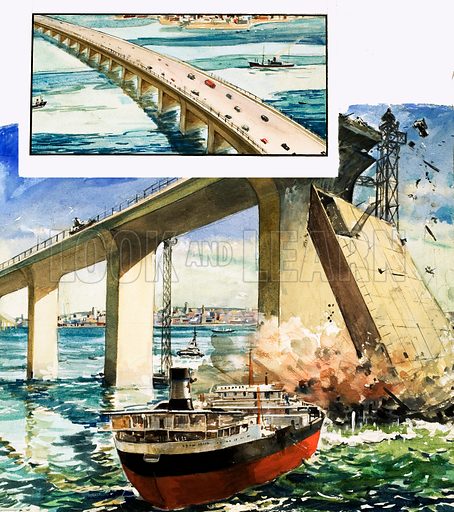
|
For more articles like this go to the Look and Learn articles website. |

Work was well behind schedule on the great West Gate Bridge that was being built to span the Lower Yarra at Melbourne, in Australia. Labour disputes and technical problems had held things up; but at last, in the latter part of 1970, it seemed that real progress was being made.
The bridge had been designed by a London firm. Their design for the sections spanning the river involved a fairly new technique. Sections were to be assembled on the ground, lifted into place on concrete piers and welded together. Actual construction was in the hands of a Melbourne company.
Around midday on the 15th October, a phone call reached the site office from the worried chief British resident engineer, John Hindshaw. There were signs of buckling, he said, in the latest section of the bridge to be put into position. He thought it might be necessary to withdraw the men working on it.
Hardly had this call ended when disaster struck. Welders and others on the 112-metre-long section suddenly felt it shaking; then, with a hideous sound of rending metal, the structure collapsed, bringing down with it the pier supporting its exposed end.
Tragically, many construction workers had just started their lunch break – in huts built right underneath the collapsed section. Some, who heard in time the snapping of steel above them, managed to dash clear. But many were crushed to death, and many others injured. Surprisingly, several men working on the section survived their fall with minor injuries.
Many people witnessed the disaster, including a schoolboy who managed to capture a photograph of the bridge section at the very moment of the fall. Soon the shriek of sirens was heard as rescue services were rushing to the site.
They arrived to a scene of horror and confusion, with many of the dead and wounded lying in mud and ooze, while others were trapped beneath the fractured steel. Despite all efforts, the death toll eventually reached 35. Hindshaw was among those killed.
Many months of investigation followed, with fierce controversy as to the cause of the catastrophe. Criticism was levelled both at the designers and at the way the work was carried out.
Eventually, work was resumed, but it was not until 1978 that the West Gate Bridge was opened, to provide Melbourne with a link with its western suburbs. The ceremony was not entirely joyous, a solemn tribute was paid to the men who had lost their lives eight years before.